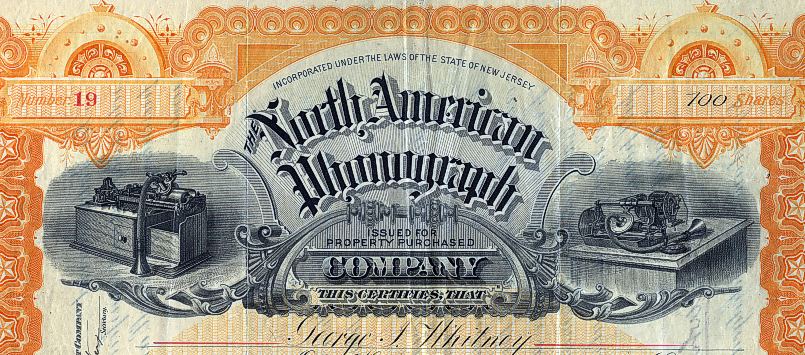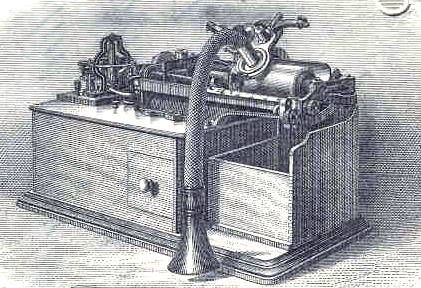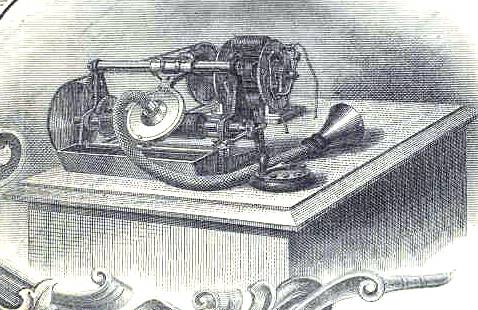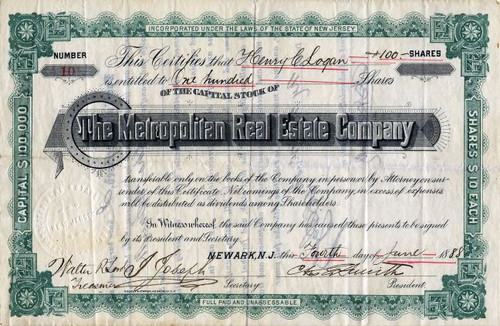Beautifully engraved RARE classic certificate #14 from the North American Phonograph Company issued on August 28, 1888. This historic document has an ornate border around it with a vignette of early phonograph machines. This item is hand signed by the Company's President ( Jessie Lippincott ) and Treasurer, John Robinson and is over 121 years old. Some wear on folds. Lowest serial number from this company we have seen. 
Certificate Vignette 
Jessie Lippincott's Signature 
Certificate Vignette 
Certificate Vignette The Edison Phonograph Company was formed on October 8, 1887, to market Edison's machine. Thomas Edison introduced the Improved Phonograph by May of 1888, shortly followed by the Perfected Phonograph. The first wax cylinders Edison used were white and made of ceresin, beeswax, and stearic wax. Edison Home Phonograph Businessman Jesse H. Lippincott assumed control of the phonograph companies by becoming sole licensee of the American Graphophone Company and by purchasing the Edison Phonograph Company from Edison. In an arrangement which eventually included most other phonograph makers as well, he formed the North American Phonograph Company on July 14, 1888. Lippincott saw the potential use of the phonograph only in the business field and leased the phonographs as office dictating machines to various member companies which each had its own sales territory. Unfortunately, this business did not prove to be very profitable, receiving significant opposition from stenographers. Meanwhile, the Edison Factory produced talking dolls in 1890 for the Edison Phonograph Toy Manufacturing Co. The dolls contained tiny wax cylinders. Edison's relationship with the company ended in March of 1891, and the dolls are very rare today. The Edison Phonograph Works also produced musical cylinders for coin-slot phonographs which some of the subsidiary companies had started to use. These proto-"jukeboxes" were a development which pointed to the future of phonographs as entertainment machines. In the fall of 1890, Lippincott fell ill and lost control of the North American Phonograph Co. to Edison, who was its principal creditor. Edison changed the policy of rentals to outright sales of the machines, but changed little else. Edison increased the entertainment offerings on his cylinders, which by 1892 were made of a wax known among collectors today as "brown wax." Although called by this name, the cylinders could range in color from off-white to light tan to dark brown. An announcement at the beginning of the cylinder would typically indicate the title, artist, and company. Advertisement for the Edison New Standard Phongraph, in Harper's, September 1898. In 1894, Edison declared bankruptcy for the North American Phonograph Company, a move that enabled him to buy back the rights to his invention. It took two years for the bankruptcy affairs to be settled before Edison could move ahead with marketing his invention. The Edison Spring Motor Phonograph appeared in 1895, even though technically Edison was not allowed to sell phonographs at this time because of the bankruptcy agreement. In January 1896, he started the National Phonograph Company which would manufacture phonographs for home entertainment use. Within three years, branches of the company were located in Europe. Under the aegis of the company, he announced the Spring Motor Phonograph in 1896, followed by the Edison Home Phonograph, and he began the commercial issue of cylinders under the new company's label. A year later, the Edison Standard Phonograph was manufactured, and then exhibited in the press in 1898. This was the first phonograph to carry the Edison trademark design. Prices for the phonographs had significantly diminished from its early days of $150 (in 1891) down to $20 for the Standard model and $7.50 for a model known as the Gem, introduced in 1899. Standard-sized cylinders, which tended to be 4.25" long and 2.1875" in diameter, were 50 cents each and typically played at 120 r.p.m. A variety of selections were featured on the cylinders, including marches, sentimental ballads, coon songs, hymns, comic monologues and descriptive specialities, which offered sound reenactments of events. The early cylinders had two significant problems. The first was the short length of the cylinders, only 2 minutes. This necessarily narrowed the field of what could be recorded. The second problem was that no mass method of duplicating cylinders existed. Most often, performers had to repeat their performances when recording in order to amass a quantity of cylinders. This was not only time-consuming, but costly. The Edison Concert Phonograph, which had a louder sound and a larger cylinder measuring 4.25" long and 5" in diameter, was introduced in 1899, retailing for $125 and the large cylinders for $4. The Concert Phonograph did not sell well, and prices for it and its cylinders were dramatically reduced. Their production ceased in 1912. Catalog for Edison cylinder records, September 1911. A process for mass-producing duplicate wax cylinders was put into effect in 1901. The cylinders were molded, rather than engraved by a stylus, and a harder wax was used. The process was referred to as Gold Moulded, because of a gold vapor given off by gold electrodes used in the process. Sub-masters were created from the gold master, and the cylinders were made from these molds. From a single mold, 120 to 150 cylinders could be produced every day. The new wax used was black in color, and the cylinders were initially called New High Speed Hard Wax Moulded Records until the name was changed to Gold Moulded. By mid-1904, the savings in mass duplication was reflected in the price for cylinders which had been lowered to 35 cents each. Beveled ends were made on the cylinders to accommodate titles. A new business phonograph was introduced in 1905. Similar to a standard phonograph, it had alterations to the reproducer and mandrel. The early machines were difficult to use, and their fragility made them prone to failure. Even though improvements were made to the machine over the years, they still cost more than the popular, inexpensive Dictaphones put out by Columbia. Electrical motors and controls were later added to the Edison business machine, which improved their performance. (Some Edison phonographs made before 1895 also had electric motors, until they were replaced by spring motors.) At this point, the Edison business phonograph became a dictating system. Three machines were used: the executive dictating machine, the secretarial machine for transcribing, and a shaving machine used to recycle used cylinders. This system can be seen in the Edison advertising film, The Stenographer's Friend, filmed in 1910. An improved machine, the Ediphone, was introduced in 1916 and steadily grew in sales after World War I and into the 1920's. Catalog for Edison moulded cylinder records, March 1903. In terms of playing time, the 2-minute wax cylinder could not compete well against competitors' discs, which could offer up to four minutes. In response, the Amberol Record was presented in November 1908, which had finer grooves than the two-minute cylinders, and thus, could last as long as 4 minutes. The two-minute cylinders were then referred to in the future as Edison Two-Minute Records, and then later as Edison Standard Records. In 1909, a series of Grand Opera Amberols (a continuation of the two-minute Grand Opera Cylinders introduced in 1906) was put on the market to attract the higher-class clientele, but these did not prove successful. The Amberola I phonograph was introduced in 1909, a floor-model luxury machine with high-quality performance, and was supposed to compete with the Victrola and Grafonola. In 1910, the company was reorganized into Thomas A. Edison, Inc. Frank L. Dyer was initially president, then Edison served as president from December 1912 until August 1926, when his son, Charles, became president, and Edison became chairman of the board. Columbia, one of Edison's chief competitors, abandoned the cylinder market in 1912. (Columbia had given up making its own cylinders in 1909, and until 1912 was only releasing cylinders which it had acquired from the Indestructible Phonographic Record Co.) The United States Phonograph Co. ceased production of its U.S. Everlasting cylinders in 1913, leaving the cylinder market to Edison. The disc had steadily grown in popularity with the consumer, thanks especially to the popular roster of Victor artists on disc. Edison refused to give up the cylinder, introducing instead the Blue Amberol Record, an unbreakable cylinder with what was arguably the best available sound on a recording at the time. The finer sound of the cylinder was partly due to the fact that a cylinder had constant surface speed from beginning to end in contrast to the inner groove distortion that occurred on discs when the surface speed slowed down. Partisans of Edison also argued that the vertical cut in the groove produced a superior sound to the lateral cut of Victor and other disc competitors. Cylinders, though, had truly peaked by this time, and even the superior sound of the Blue Amberols could not persuade the larger public to buy cylinders. Edison conceded to this reality in 1913 when he announced the manufacture of the Edison Disc Phonograph. The Edison Company did not desert its faithful cylinder customers, however, and continued to make Blue Amberol cylinders until the demise of the company in 1929, although most from 1915 on were dubbed from the Diamond Discs. History from Wikipedia and OldCompanyResearch.com.

Certificate Vignette

Jessie Lippincott's Signature

Certificate Vignette

Certificate Vignette








